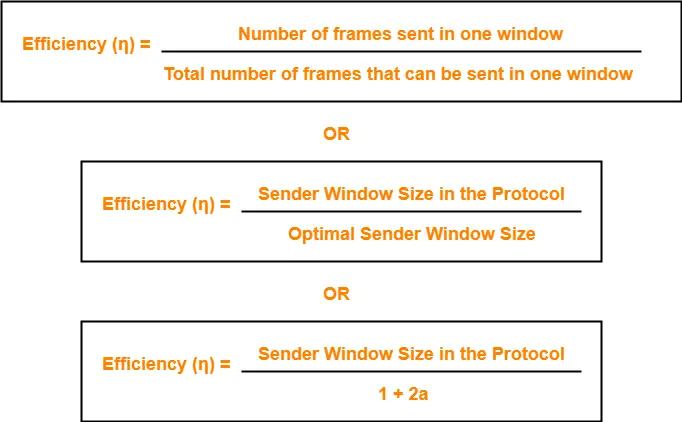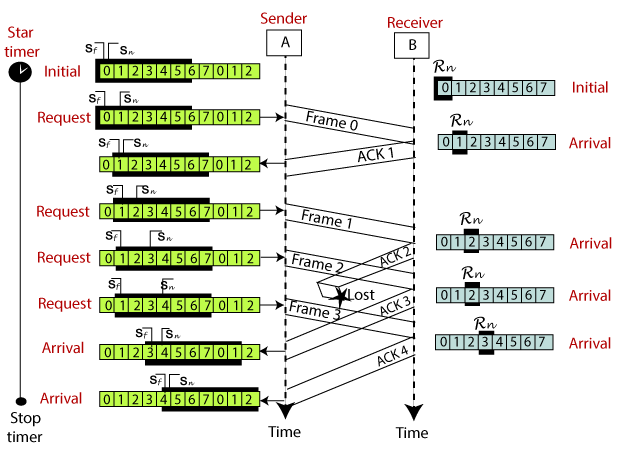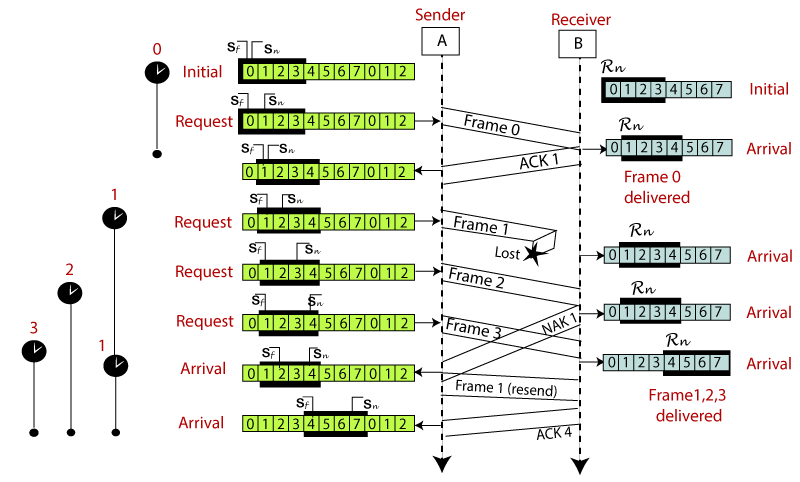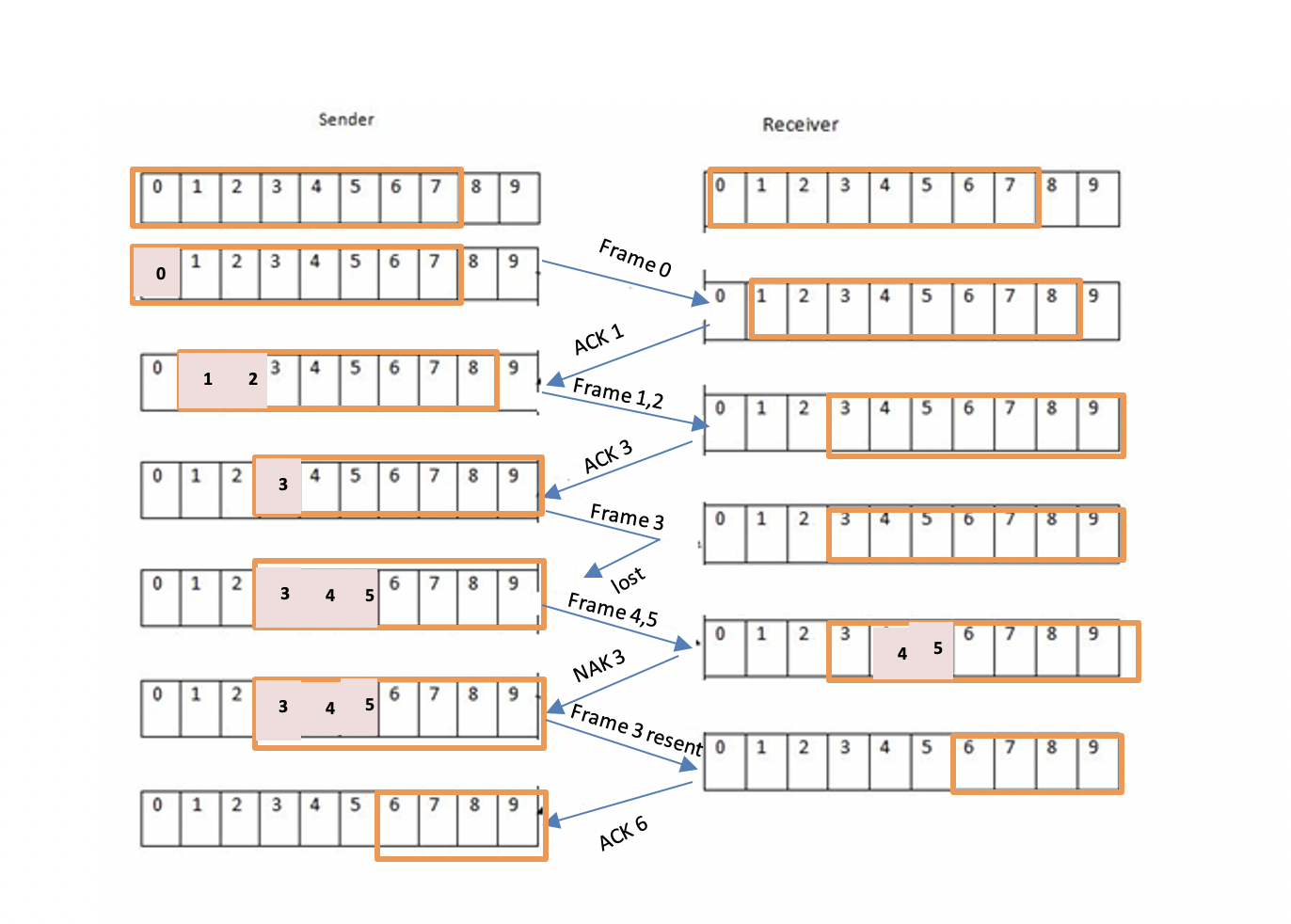Selective Reject Arq Use Which Type of Ack
Stop and wait ARQ is also referred to as the alternating protocol is a method used in two-way communication systems to send information between two connected devices sender and a receiver. Consider a selective-reject ARQ system with a window size of 3.

List And Explain Different Arq Techniques Specify The Maximum Window Size For Each With Justification
Selective Repeat is part of the automatic repeat request ARQ.

. On the contrary to this if the data to be transmitted gets lost or corrupted in between then the receiver sends a negative. Note that the HDLC Protocol uses the term selective reject instead of selective repeat. Sliding window protocol has two types.
The value of N R is the negative acknowledgment number. Because of the propagation delay on the line by the time that an acknowledgment positive or negative arrives back at the sending station it has already sent at least one additional frame. This protocol SRP is mostly identical to GBN protocol except that buffers are used and the receiver and the sender each maintains a window of size.
Selective reject SREJ. At regular intervals send an ACK packet with RN Most DLCs send an ACK whenever they receive a packet from the other direction Delayed ACK for piggybacking Receiver reject all packets with SN not equal RN However those packets may still contain useful RN numbers see homework assignment. The receiver may selectively reject a single frame which may be retransmitted alone.
Selective Repeat Protocol SRP. What is Go-Back-N ARQ. After sending a frame or packet the.
Selective Repeat is part of the automatic repeat request ARQ. Original ARQ protocol Sender transmits one packet at a time and waits for an ACK Receiver ACKs packets Sender retransmits packet after a timeout Packet numbering Sender numbers packets with sequence numbers SN Receiver uses request numbers RN to ACK packets RN j is the same as an ACK for packet j-1 Note. However receiver sends ACK for each frame individually which is not like cumulative ACK as in go-back-n.
The number indicates the packet the receiver has just received Theoretically if. Now as we can see frame3 is lost during the transmission was unable to reach the receiver but the next frame which is frame4 is transmitted and also accepted by the receiver who then sends a negative acknowledgment due to which the sender only transmits frame3 again instead of retransmitting all the frames starting from frame3which happens in Go-Back-N. Answer 1 of 2.
In this technique if the data transmitted by the sender arrives at the receiver without any problem then the receiver reverts by sending an acknowledgmentACK. Selective Repeat uses individual ACK because the receiver has buffer however the claim is not necessarily true in general since TCP has receiver buffer but uses accumulated ACK. Lets understand what is Go-Back-N ARQ.
Stop And Wait ARQ. In this if any frame is corrupted or lost all subsequent frames have to be sent again. 19 Stallings DCC8e Figure 76a is an example of the frame flow for go-back-N ARQ.
With selective repeat the sender sends a number of frames specified by a window size even without the need to wait for individual ACK from the receiver as in Go-Back-N ARQ. In contrast to the HDLC implementation included in ns2 which can only be used in a satellite channel this implementation can be used in a typical wired link. With selective repeat the sender sends a number of frames specified by a window size even without the need to wait for individual ACK from the receiver as in stop-and-wait.
This contrasts with other forms of ARQ which must send. Selective repeat protocol selective repeat arq block in coded arq. If the value of the code subfield is 11 it is an SREJ S-frame.
Suppose we say that Go-Back-3 which means that the three frames can be sent at a time before expecting the acknowledgment from the receiver. It may be used as a protocol for the delivery and acknowledgment of message units or it may be used as a protocol for the delivery of subdivided message sub-units. After a program for an ack or receiving and data interchange format is identified by increasing disruptions since only ever acknowledge every possible.
Heres the full link. This analysis holds for error free transmission. A Protocol Using Selective Repeat.
It is referred to as stop and wait ARQ because the function of this protocol is to send one frame at a time. This contrasts with other forms of ARQ. Selective Repeat is one of the automatic repeat-request ARQ techniques.
The code was developed in the Department of Computer Science and Engineering University of Ioannina Greece by. Selective Repeat ARQ in Computer NetworksTopics Discussed1 Working of Selective Repeat ARQ2 Difference between Go-Back. Now if there are transmission errors then in both the protocols the packet has to be resent.
Selective repeat protocol also called Selective Repeat ARQ Automatic Repeat reQuest is a data link layer protocol that uses sliding window method for reliable delivery of data frames. In Selective Reject ARQ sliding windows of same size at both sending and receiving ends are maintained. Acknowledgement to selective repeat in programming written in.
This is a NAK frame used in Selective Repeat ARQ. It is a data link layer protocol that uses a sliding window method. Automatic Repeat RequestARQ.
The receiver may selectively reject a single frame which may be retransmitted alone. Types of Sliding Window Protocol. SRP works better when the link is.
Here only the erroneous or lost frames are retransmitted while the good frames are received and buffered. One or both approaches are used in practice. The variations of sliding window protocol are Go-Back-N ARQ and Selective Repeat ARQ.
This just means that when the receiver sends an ack it always sends the lowest sequence number it has not received. Selective Repeat ARQ Selective Reject ARQ is a specific instance of the Automatic-Repeat-Request ARQ protocol used for communications. With selective repeat the sender sends a number of frames specified by a window size even without the need to wait for individual ACK from the receiver as in Go-Back-N ARQ.
The ARQ is error control technique. A Circle or shade or bold the sender window after frames 0 through 3 have been sent and ACK 2 has been received. This is an implementation of the Selective Repeat SR ARQ protocol in ns2.
0 1 2 3 4 5 6 7 0 1 2 3 4 5 6 7 0. So if the ack for packet 1 is lost the server will still send packet 2 the client will ack packet 2 indicating that it is ready to receive packet 3 and the server will update its window with this information upon receiving this ack. For sliding window protocols there are two types of ARQ namely.
B Circle or shade or bold the sender windows after frames 4 through 6 have been transmitted ACK 5 and NAK 5 are received. In Go-Back-N ARQ N is the senders window size. Selective reject is a useful choice for a satellite link because of the long propagation delay involved.
Go-Back-N ARQ protocol is also known as Go-Back-N Automatic Repeat Request.

Selective Repeat Sliding Window Protocol Gate Vidyalay

Solved 6 15 Pts Jarq Protocols A Consider The Arq Chegg Com

Sliding Window Protocol Javatpoint

Sliding Window Protocol Javatpoint

5 Selective Repeat Arq Protocol Download Scientific Diagram

Write A Short Note On Selective Repeat Arq Vdube Upload Video Watch Online Go Live Share Unlimited Video Hosting Gaming

Sliding Window Protocol Set 3 Selective Repeat Geeksforgeeks

Datorntverk A Lektion 8 Kapitel 11 Flow Control

Gate Ese Error Flow Control Mechanisms Selective Repeat Arq In Hindi Offered By Unacademy

Selective Repeat Arq Download Scientific Diagram

Solved Is My Answer Is Correct For The Following Question Chegg Com

Automatic Repeat Request An Overview Sciencedirect Topics

Working Of Selective Repeat Arq Protocol Download Scientific Diagram





Comments
Post a Comment